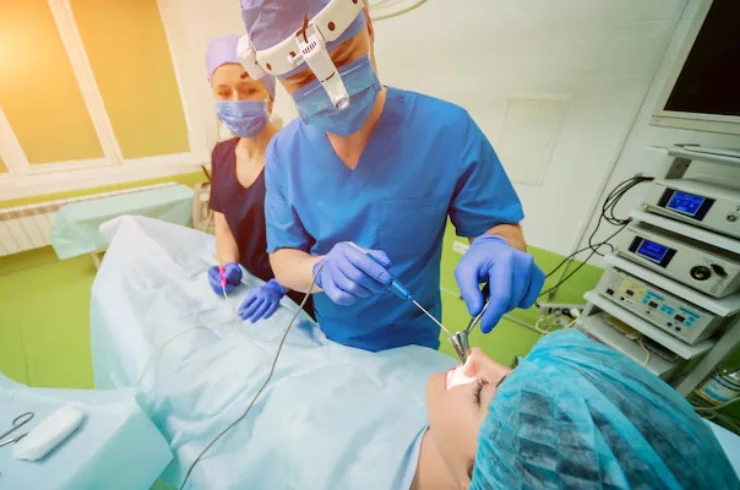Trans Nasal Transsphenoidal Surgery

Transnasal Transsphenoidal Surgery (TNTS) is a minimally invasive procedure used to remove tumors or lesions located at the base of the skull, particularly in the pituitary gland. This technique involves accessing the tumor through the nasal passages and sphenoid sinus, avoiding the need for external incisions, and providing a faster recovery time for the patient. It is a common treatment for pituitary tumors, which can lead to a variety of hormonal imbalances and neurological symptoms if left untreated.
Indications for Transnasal Transsphenoidal Surgery
This procedure is primarily used for treating:
- Pituitary Tumors: Non-cancerous growths in the pituitary gland (adenomas) that can cause hormonal imbalances, vision problems, or headaches.
- Craniopharyngiomas: Benign tumors located near the pituitary gland.
- Meningiomas: Tumors that develop in the meninges (the protective layers of the brain and spinal cord), often near the pituitary region.
- Rathke’s Cleft Cyst: A benign cyst in the pituitary area that may need removal if symptomatic.
- Other Sellar and Parasellar Lesions: Tumors or abnormalities located in the sellar and parasellar regions.
Procedure Overview
- Preparation and Anesthesia: The surgery is typically performed under general anesthesia, ensuring that the patient is fully relaxed and pain-free.
- Accessing the Tumor: The surgeon inserts an endoscope or specialized surgical instruments into the nasal passages. Through the nasal cavity, the surgeon accesses the sphenoid sinus, which is directly beneath the pituitary gland.
- Tumor Removal: Using the endoscope or microscopic visualization, the surgeon carefully removes the tumor or lesion, often with the help of surgical tools designed for delicate work. In some cases, the tumor may be fragmented and removed piecemeal.
- Closure: After the tumor is removed, the surgical site is carefully examined. The nose and sinus areas are typically sealed with a small nasal pack, and the sphenoid sinus is closed. No external incisions are required, which helps minimize scarring.
Benefits of Transnasal Transsphenoidal Surgery
- Minimally Invasive: Since the surgery is performed through the nasal passages, there are no external incisions, leading to reduced scarring and a faster recovery.
- Enhanced Precision: The use of endoscopy allows for precise visualization and removal of the tumor, especially in areas that are difficult to reach with traditional surgical methods.
- Shorter Recovery Time: Patients generally experience less pain and swelling compared to open surgery, with many able to return home within a few days after surgery.
- Reduced Risk of Complications: The procedure is associated with fewer complications such as infections, nerve damage, and blood loss compared to more invasive surgeries.
Recovery and Postoperative Care
- Hospital Stay: Most patients remain in the hospital for 1-2 days for observation. In some cases, a longer stay may be required, depending on the complexity of the surgery and the patient’s condition.
- Follow-up Appointments: Regular follow-up visits are essential to monitor recovery, manage any hormonal changes, and evaluate the success of the tumor removal. Imaging tests such as MRI or CT scans are often performed to ensure that the tumor has been fully removed.
- Postoperative Symptoms: Some patients may experience mild nasal congestion, headache, or a runny nose post-surgery. These symptoms usually resolve within a few weeks. The doctor may also recommend nasal saline sprays or other treatments to ease healing.
Risks and Complications
While transnasal transsphenoidal surgery is generally safe, like any procedure, there are risks:
- Infection: As with any surgery, there is a risk of infection at the surgical site.
- CSF Leak: A cerebrospinal fluid leak may occur, which can lead to complications such as meningitis if not treated promptly.
- Hormonal Imbalances: If the pituitary gland is affected during the procedure, it can lead to hormonal deficiencies, requiring lifelong hormone replacement therapy.
- Bleeding: Though rare, excessive bleeding may occur during or after the surgery.
